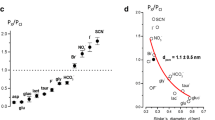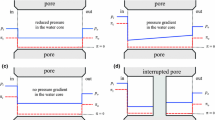Abstract
A decrease in external osmolarity results in cell swelling and the immediate activation of a mechanism to restore cell volume, known as regulatory volume decrease (RVD). When exposed to a gradual osmolarity decrease (GODE), some cells do not swell. This reflects the operation of an active regulatory process known as isovolumetric regulation (IVR). The mechanisms underlying IVR appear similar to those activated during RVD, namely the extrusion of K+, Cl−, amino acids, and other organic molecules. A previous study has documented IVR in cerebellar granule neurons, parallel to an early efflux of taurine and Cl−, whereas K+ efflux is delayed. In this work we briefly review the importance of amino acids in the mechanisms of cell volume control in the brain, with emphasis on IVR. We also present experiments showing the response to GODE in cerebellar astrocytes. The currents activated during GODE, recorded in the whole-cell configuration of the patch clamp technique, indicate the early activation of an anion current, followed by a more delayed cation current. A correlation between the time course of amino acid efflux during GODE and the occurrence or not of IVR in various cell types, suggest the importance of these osmolytes in the volume regulatory process in this model.
Similar content being viewed by others
REFERENCES
Lang, F., Busch, G. L., Ritter, M., Volkl, H., Waldegger, S., Gulbins, E., and Haussinger, D. 1998. Functional significance of cell volume regulatory mechanisms. Physiol. Rev. 78:247–306.
Kimelberg, H. K. 1995. Current concepts of brain edema: Review of laboratory investigations. J. Neurosurg. 83:1051–1059.
Pasantes-Morales, H. 1996. Volume regulation in brain cells: Cellular and molecular mechanisms. Metab. Brain. Dis. 11:187–204.
Okada, Y. 1997. Volume expansion-sensing outward-rectifier Cl− channel: Fresh start to the molecular identity and volume sensor. Am. J. Physiol. 273:C755–C789.
Pasantes-Morales, H. and Morales-Mulia, S. 2000. Influence of calcium on regulatory volume decrease: Role of potassium channels. Nephron 86:414–427.
Sanchez-Olea, R., Moran, J., Schousboe, A., and Pasantes-Morales, H. 1991 Hyposmolarity-activated fluxes of taurine in astrocytes are mediated by diffusion. Neurosci. Lett. 130:233–236.
Junankar, P. R. and Kirk, K. 2000. Organic osmolyte channels: A comparative view. Cell. Physiol. Biochem. 10:355–360.
Strange, K., Emma, F., and Jackson, P. S. 1996. Cellular and molecular physiology of volume-sensitive anion channels. Am. J. Physiol. 270:C711–C730.
Mongin, A. A. and Orlov, S. N. 2001. Mechanisms of cell volume regulation and possible nature of the cell volume sensor. Pathophysiology. 8:77–88.
Pasantes-Morales, H. and Franco, R. 2002. Influence of protein tyrosine kinases on taurine release. Cerebellum. 1:103–109.
Pasantes-Morales, H., Franco, R., Ochoa, L., and Ordaz, B. 2002. Osmosensitive release of neurotransmitter amino acids: Relevance and mechanisms. Neurochem. Res. 27:59–65.
Andrew, R. D. 1991. Seizure and acute osmotic change: Clinical and neurophysiological aspects. J. Neurol. Sci. 101:7–18.
Schwartzkroin, P. A., Baraban, S. C., and Hochman, D. W. 1998. Osmolarity, ionic flux, and changes in brain excitability. Epilepsy Res. 32:275–285.
Verbalis, J. G. and Gullans, S. R. 1991. Hyponatremia causes large sustained reductions in brain content of multiple organic osmolytes in rats. Brain Res. 567:274–282.
Sterns, R. H, Baer, J., Ebersol, S., Thomas, D., Lohr, J. W., and Kamm, D. E. 1993. Organic osmolytes in acute hyponatremia. Am. J. Physiol. 264:F833–F836.
Taylor, D. L., Davies, S. E., Obrenovitch, T. P., Doheny, M. H., Patsalos, P. N., Clark, J. B., and Symon, L. 1995. Investigation into the role of N-acetylaspartate in cerebral osmoregulation. J. Neurochem. 65:275–281.
Pasantes-Morales, H., Maar, T. E., and Moran, J. 1993. Cell volume regulation in cultured cerebellar granule neurons. J. Neurosci. Res. 34:219–224.
Pasantes-Morales, H., Murray, R. A., Lilja, L., and Moran, J. 1994. Regulatory volume decrease in cultured astrocytes: I. Potassium-and chloride-activated permeability. Am. J. Physiol. 266:C165–C171.
Pasantes-Morales, H., Murray, R. A., Sanchez-Olea, R., and Moran, J. 1996. Regulatory volume decrease in cultured astrocytes: II. Permeability pathway to amino acids and polyols. Am. J. Physiol. 266:C172–C178.
Basavappa, S., Huang, C. C., Mangel, A. W., Lebedev, D. V., Knauf, P. A., and Ellory, J. C. 1996. Swelling-activated amino acid efflux in the human neuroblastoma cell line CHP-100. J. Neurophysiol. 76:764–769.
Strange, K. and Morrison, R. 1992. Volume regulation during recovery from chronic hypertonicity in brain glial cells. Am. J. Physiol. 263:C412–C419.
Pasantes-Morales, H., Cardin, V., Morales-Mulia, S., and Quesada, O. 1998. Regulatory volume decrease in cultured brain cells: Rate limiting factors. Pages 43–56, in Okada, Y. (ed.), Cell volume regulation: The molecular mechanism and volume sensing machinery. Amsterdam: Elsevier Science.
Law, R. O. 1994. Taurine efflux and the regulation of cell volume in incubated slices of rat cerebral cortex. Biochim. Biophys. Acta. 1221:21–28.
Bothwell, J. H., Rae, C., Dixon, R. M., Styles, P., and Bhakoo, K. K. 2001. Hypo-osmotic swelling-activated release of organic osmolytes in brain slices: Implications for brain oedema in vivo. J. Neurochem. 77:1632–1640.
Estevez, A. Y., O'Regan, M. H., Song, D., and Phillis, J. W. 1999. Effects of anion channel blockers on hyposmotically induced amino acid release from the in vivo rat cerebral cortex. Neurochem. Res. 24:447–452.
Solis, J. M., Herranz, A. S., Herreras, O., Lerma, J., and Martin del Rio, R. 1988. Does taurine act as an osmoregulatory substance in the rat brain? Neurosci. Lett. 91:53–58.
Pasantes-Morales, H., Franco, R., Torres-Marquez, M. E., Hernandez-Fonseca, K., and Ortega, A. 2000. Amino acid osmolytes in regulatory volume decrease and isovolumetric regulation in brain cells: Contribution and mechanisms. Cell. Physiol. Biochem. 10:361–370.
Lohr, J. W. and Grantham, J. J. 1986. Isovolumetric regulation of isolated S2 proximal tubules in anisotonic media. J. Clin. Invest. 78:1165–1172.
Van Driessche, W., De Smet, P., Li, J., Allen, S., Zizi, M., and Mountian, I. 1997. Isovolumetric regulation in a distal nephron cell line (A6). Am. J. Physiol. 272:C1890–C1898.
Tuz, K., Ordaz, B., Vaca, L., Quesada, O., and Pasantes-Morales, H. 2001. Isovolumetric regulation mechanisms in cultured cerebellar granule neurons. J. Neurochem. 79:143–151.
Franco, R., Quesada, O., and Pasantes-Morales, H. 2000. Efflux of osmolyte amino acids during isovolumic regulation in hippocampal slices. J. Neurosci. Res. 61:701–711.
Lohr, J. W. and Yohe, L. 2000. Isovolumetric regulation of rat glial cells during development and correction of hypo-osmolality. Neurosci. Lett. 286:5–8.
Souza, M. M., Boyle, R. T., and Lieberman, M. 2000. Different physiological mechanisms control isovolumetric regulation and regulatory volume decrease in chick embryo cardiomyocytes. Cell. Biol. Int. 24:713–721.
Godart, H., Ellory, J. C., and Motais, R. 1999. Regulatory volume response of erythrocytes exposed to a gradual and slow decrease in medium osmolality. Pflugers Arch. 437:776–779.
McManus, M., Fischbarg, J., Sun, A., Hebert, S., and Strange, K. 1993. Laser light-scattering system for studying cell volume regulation and membrane transport processes. Am. J. Physiol. 265:C562–C570.
Olson, J. E. and Li, G. Z. 1997. Increased potassium, chloride, and taurine conductances in astrocytes during hypoosmotic swelling. Glia. 20:254–261.
Kimelberg, H. K., Anderson, E., and Kettenmann, H. 1990. Swelling-induced changes in electrophysiological properties of cultured astrocytes and oligodendrocytes: II. Whole-cell currents. Brain Res. 529:262–268.
Olson, J. E. 1999. Osmolyte contents of cultured astrocytes grown in hypoosmotic medium. Biochim. Biophys. Acta. 1453:175–179.
Author information
Authors and Affiliations
Corresponding author
Rights and permissions
About this article
Cite this article
Ordaz, B., Tuz, K., Ochoa, L.D. et al. Osmolytes and Mechanisms Involved in Regulatory Volume Decrease Under Conditions of Sudden or Gradual Osmolarity Decrease. Neurochem Res 29, 65–72 (2004). https://doi.org/10.1023/B:NERE.0000010434.06311.18
Issue Date:
DOI: https://doi.org/10.1023/B:NERE.0000010434.06311.18




